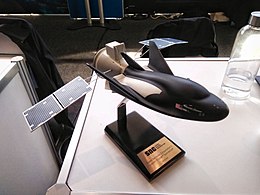


Scale model of the Dream Chaser Cargo System with the Shooting Star module
| |
| Names | SSC Demo-1 |
|---|---|
| Mission type | Flight test, ISS resupply |
| Operator | Sierra Nevada |
| Website | sierraspace |
| Mission duration | 82 days (planned)[1] |
| Spacecraft properties | |
| Spacecraft | Dream Chaser Tenacity |
| Spacecraft type | Dream Chaser |
| Manufacturer |
|
| Start of mission | |
| Launch date | 2025 (planned)[2] |
| Rocket | Vulcan Centaur VC4L[a][3] |
| Launch site | Cape Canaveral, SLC-41 |
| Contractor | United Launch Alliance |
| Orbital parameters | |
| Reference system | Geocentric orbit |
| Regime | Low Earth orbit |
| Inclination | 51.6° |
| Berthing at ISS | |
| Berthing port | Harmony nadir or Unity nadir |
|
← CRS-31
CRS-32 →
CRS-1 →
| |
SSC Demo-1, also known as Dream Chaser Demo-1, is the planned first flight of the Sierra Space robotic resupply spacecraft Dream Chaser to the International Space Station (ISS) under the CRS-2 contract with NASA. The demonstration mission is planned for launch no earlier than 2025.[2][4]
In April 2021 the Dream Chaser division of the Sierra Nevada Corporation (SNC) was spun-off, creating the new fully independent company, the Sierra Space Corporation (SSC), which assumed full oversight over the Dream Chaser program. The company developed a new reusable spacecraft to provide commercial cargo resupply services to the International Space Station (ISS), based on decades of lifting body programs. Under the Commercial Orbital Transportation System (COTS) program, the company designed Dream Chaser with industrial partner Lockheed Martin.
The company also designed the accompanying Shooting Star cargo module with subcontractor Applied Composites.[5] At the end of mission, the Shooting Star will destructively reenter the atmosphere and the Dream Chaser will land at the Kennedy Space Center's Shuttle Landing Facility.
The Dream Chaser Cargo System will fly cargo resupply missions to the ISS under NASA's Commercial Resupply Services-2 program. This system features the Shooting Star, an expendable cargo module with solar panels, and the Dream Chaser, a reusable lifting body capable of returning 1,750 kg (3,860 lb) of pressurized cargo to Earth while undergoing maximum re-entry forces of 1.5 g.[6][7]
The Dream Chaser design is derived from NASA's HL-20 Personnel Launch System spaceplane concept from the 1990s, which in turn is descended from over 20,000 hours and six decades of experimental lifting body vehicles, including the X-20 Dyna-Soar, Northrop M2-F2, Northrop M2-F3, Northrop HL-10, Martin X-24A and X-24B, and Martin X-23 PRIME.[8][9][10][11]
The vehicle to be used in SSC Demo-1 is named Tenacity.[12][13] The Shooting Star carries pressurized and unpressurized cargo, and serves as the power supply for the Dream Chaser.[7] The Shooting Star will have a cargo capacity of 4,536 kg (10,000 lb). Its design is similar to the Exoliner cargo container shown in Lockheed Martin's Jupiter proposal for NASA's CRS-2.
SSC Demo-1 is the Dream Chaser demonstration mission under the Commercial Resupply Services-2 (CRS-2) contract with NASA. Production and integration of the Dream Chaser spacecraft is performed in Texas, Colorado, and Florida. The Dream Chaser is mated with the Shooting Star at the launch site, and mission operations are conducted from control centers in Colorado and Houston, Texas. Sierra Nevada selected ULA's Vulcan Centaur as its launch vehicle for this Demo-1 mission and the six contracted NASA CRS-2 missions.[14][15][16]
Peregrine will fly on a VC2S, Dream Chaser will fly on a VC4L.
...The HL-20's baseline design has evolved from manned lifting bodies flown for the Defense Dept, during the 1960s and owes much of its overall layout to the Martin X-24A...
... The NASA lifting-body program has been well documented in about 100 technical reports on the program's 222 flights and 20,000 hours of wind-tunnel tests. Many of these publications are unclassified. The Soviet Union purchased copies of these reports from NASA Headquarters in Washington, D.C., then designed its own lifting body. In 1982, the Soviets flight-tested an unpiloted, 10-foot-long, subscale version of their lifting body, the BOR-4, including a maneuvering re-entry over the Indian Ocean from space orbit. The flight test of the BOR-4 closely resembled that of our PRIME (X-23) vehicle in 1966...
... A mock-up of the proposed "space taxi", called the HL-20 Personnel Launch System, closely resembles a Soviet subscale spaceplane flown on four orbital missions in the 1980s... However, Piland, chief of the space systems division at the Langley Research Center, was quick to point out the Soviet test vehicle seems to have evolved from U. S. lifting-body configurations flown from 1966 to 1975 — such as Northrop's HL-10, M2-F2 and M2-F3 and Martin's X-24A and X-24B...
... The lifting-body program came to an official end in 1975. Yet like a Phoenix rising from the ashes, the concept has appeared several times since then in proposed NASA spacecraft. When the Langley Research Center revealed its HL-20 design for an emergency crew return vehicle or small mini-Shuttle in 1990, the shape was remarkably similar to the HL-10 and X-24A designs...
|
| |
|---|---|
| |
| Launch vehicles |
|
| Operator |
|
| Missions |
|
| Related vehicles |
|
|
| ||
|---|---|---|
| ||
| 2000–2004 |
| |
| 2005–2009 |
| |
| 2010–2014 |
| |
| 2015–2019 |
| |
| 2020–2024 |
| |
| Future |
| |
| Spacecraft |
| |
| ||